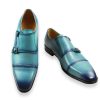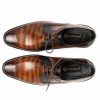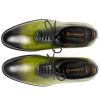A Deep Dive Into Luxury Craftsmanship, Value & Alternatives for Premium Horsebit Shoes
At Handsole, we’ve analyzed the craftsmanship, materials, and value proposition of high-end horsebit loafers to deliver this definitive review. We examine the 200+ hand-applied processes behind luxury construction, assess real-world comfort, explore styling versatility, and reveal strategic alternatives. Whether you’re contemplating the splurge or seeking worthy options, this guide delivers expert insights.
An Icon Born in the Saddle: The Horsebit Legacy
The horsebit loafer story begins in 1953 when Italian designers transformed a functional equestrian detail into revolutionary footwear ornamentation. This became a statement merging European craftsmanship with sophisticated style. Within years, the design achieved cult status among presidents and cultural icons. By 1969, luxury brands sold over 80,000 pairs annually in the US alone. In 1985, the style earned a rare honor: becoming the first shoe inducted into the MoMA’s permanent collection.
While brands have experimented with variations – backless designs, chunky soles – the classic horsebit model remains the purest expression. Its enduring appeal lies in this rich narrative; wearing premium versions connects you to decades of sartorial history.
Deconstructing Luxury: Where $1,000+ Goes
Behind the iconic hardware lies complex construction involving over 200 hand-applied steps at premier workshops. Here’s what justifies premium pricing:
Materials & Construction
- Premium Leathers: Top-tier horsebit loafers feature supple calfskin, exotic leathers, or heritage hides from renowned European tanneries. The exact tannage and finishing processes are closely guarded secrets that create distinctive character and deep patina development.
- Hand-Stitched Apron: The defining apron toe is meticulously hand-stitched by master artisans. This moccasin-style construction requires significant skill to achieve perfect tension and alignment, with slight puckering as a hallmark of genuine handwork.
- Blake/Rapid Stitch Construction: Many premium makers use flexible stitching methods that attach soles directly to uppers, creating sleeker profiles and immediate comfort. The stitching is often recessed into grooves for clean aesthetics.
- Signature Hardware: The 24k gold-plated brass horsebits feature precise weight distribution and flawless shaping that distinguishes luxury models.
The Pros: Justifying the Investment
- Timeless, Logo-Free Design: Status conveyed through distinctive hardware and silhouette rather than overt branding
- Immediate Comfort: Supple leathers and flexible construction mean minimal break-in period
- Resale Value: Well-maintained luxury pairs retain 40-60% value on secondary markets
- Versatility: Transitions seamlessly from business attire to weekend wear
- Heritage Craftsmanship: Ownership of artisanal footwear tradition
The Cons: Considerations
- Price Premium: Significant markup for brand heritage vs. material costs
- Delicate Soles: Many feature thin leather soles requiring protective taps
- Resoling Costs: Specialized construction requires expert recrafting ($100-$250)
- Material Variations: Some luxury versions use textile linings rather than full leather
All-Day Comfort or Style Compromise?
Our testing reveals surprising comfort in premium horsebit loafers despite elegant silhouettes:
- Break-in Period: Flexible construction and supple leathers mean minimal discomfort during initial wears
- Footbed Evolution: Leather insoles mold to feet over time, though arch support is typically minimal
- Sizing Considerations: Most run true-to-size but narrow; wider fits often require special ordering
As footwear experts note: “True luxury loafers should offer both immediate comfort and enduring style – anything less compromises the premium proposition.”
Style Versatility: From Boardroom to Weekend
This is where premium horsebit loafers truly justify their cost:
- Business & Smart Casual: Pair effortlessly with suits, dress trousers, and blazers
- Contemporary Styling: Complement designer denim, wide-leg trousers, and minimalist fashion
- Seasonal Flexibility: The sockless summer look works perfectly with premium models
As noted by style authorities: “The horsebit loafer’s genius lies in its chameleon-like ability to adapt to contexts while maintaining distinctive character.”
The Luxury Alternatives: Worthy Competitors
Exceptional alternatives deliver similar aesthetics at various price points:
| Brand & Model | Price Point | Key Advantages | Considerations |
|---|---|---|---|
| Carmina Fitzgerald | $400-$600 | Goodyear welt construction, premium calfskin, resoleable | Less immediate flexibility than Blake-stitched models |
| Santoni Capri | $600-$900 | Hand-painted patinas, Norwegian construction, exceptional finishing | Higher price than entry-luxury options |
| Allen Edmonds Verona II | $200-$400 | Classic American styling, wide widths available, Goodyear welt | Less refined last shape than European makers |
| Meermin Hiro Bit | $200-$300 | Excellent value, Goodyear welted, European leathers | Longer break-in period, limited width options |
Budget Alternatives: The Reality
While sub-$100 alternatives exist, they involve significant compromises:
- Materials: Synthetic leathers lack breathability and develop artificial patina
- Construction: Glued soles prevent resoling and shorten lifespan
- Hardware: Lightweight alloys tarnish quickly under regular use
Verdict: For occasional wear, budget options suffice. For long-term value, invest in quality craftsmanship from brands like Carmina or Allen Edmonds.
The Final Verdict: Are Premium Horsebit Loafers Worth It?
Worth the investment if: You value heritage design, artisan craftsmanship, and versatile styling. Premium loafers deliver when viewed as 10+ year investments with proper care and occasional recrafting. The intangible satisfaction of owning exceptional footwear justifies the price for connoisseurs.
Not worth it if: Your priority is material value over craftsmanship prestige. Those needing rugged durability or orthopedic support will find better options elsewhere.
Ideal Buyers
- The Style Investor: Who values timeless design over trends
- The Comfort-Seeker: Who prioritizes all-day wearability
- The Versatility Maximizer: Who needs one shoe for multiple contexts
Preserving Your Investment
- Immediate Protection: Apply rubber toe taps to leather soles
- Regular Maintenance: Use cedar shoe trees and brush after wear
- Conditioning: Apply quality leather conditioner every 3-6 months
- Professional Recrafting: Use specialist services when soles wear thin












